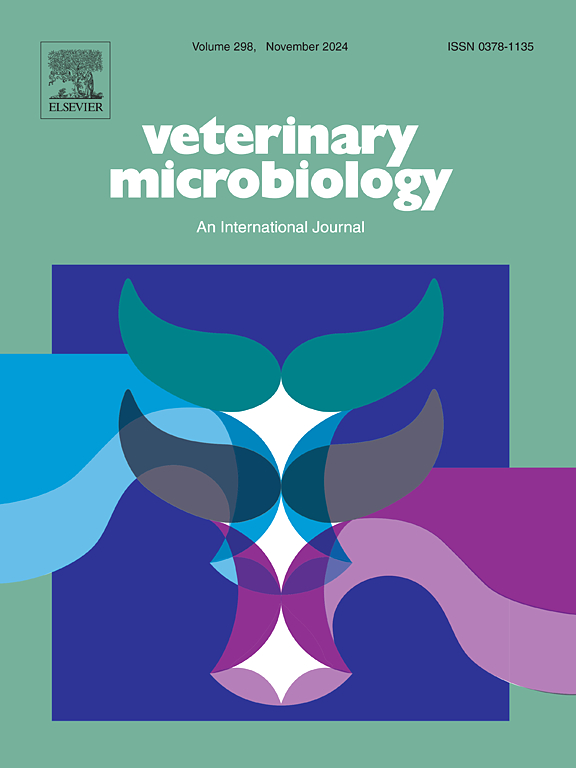Aetiology and environmental factors of the Watery Mouth Disease associated with neonatal diarrhoea in lambs
IF 2.4
2区 农林科学
Q3 MICROBIOLOGY
引用次数: 0
Abstract
Watery Mouth Disease is the main disease in neonatal lambs, causing great economic losses. Despite this, the cause of the condition remains poorly understood. Therefore, we have analysed the main bacteria found in sick animals, their intestinal and temporal distribution, as well as the main sources of contamination. Twelve different farms were sampled, from which 331 samples were taken in total. From these samples, 184 environments were analyzed using 16S rRNA amplicon sequencing, 164 isolates were identified by whole genome sequencing and 35 bacterial counts were performed. The dominant bacterial groups at the rectal level were Escherichia-Shigella (36 %) and Clostridium (29 %), with a homogeneous distribution along the digestive tract and a maximum abundance ranging between 12 and 24 hours of lamb life. Within Escherichia-Shigella: Escherichia coli and Escherichia fergusonii and within Clostridium: Clostridium perfringens, Clostridium cadaveris, Clostridium tertium and Clostridium paraputricum were identified as the main isolates present in sick animals. The high presence of Clostridium strains, especially potentially pathogenic species like C. perfringens in sick animals, point out Clostridium as a new important protagonist of watery mouth disease and the need of their inclusion in future studies. In particular, bedding was established as the main microbial contaminating factor, reaching the highest increase 48 hours after removal and cleaning of the lambing area (i.e. 8.03 ×108, 1.88 ×106, 3.88 ×106, 4.85 ×107 and 4.00 ×105 CFU/g for mesophilic aerobes, coliforms, E. coli, mesophilic anaerobes and sporulates, respectively). These results highlight the need to increase cleanliness in bedding to reduce the presence of these bacteria.
与羔羊新生儿腹泻相关的水口病的病原学和环境因素
水口病是新生羔羊的主要疾病,造成巨大的经济损失。尽管如此,这种情况的原因仍然知之甚少。因此,我们分析了在病畜身上发现的主要细菌,它们的肠道和时间分布,以及主要污染源。对12个不同的农场进行了抽样,共采集了331份样本。采用16S rRNA扩增子测序对184个环境进行分析,采用全基因组测序对164株分离菌进行鉴定,并对35株细菌进行计数。直肠水平的优势菌群为大肠杆菌-志贺氏菌(36 %)和梭菌(29 %),沿消化道分布均匀,最大丰度在羔羊生命的12 ~ 24 小时之间。在志贺氏杆菌中,大肠杆菌和弗格森杆菌是主要分离株,在病畜中,产气荚膜梭菌、尸状梭菌、tertium梭菌和副果状梭菌是主要分离株。梭状芽孢杆菌在病畜体内的大量存在,特别是产气荚膜梭状芽孢杆菌等具有潜在致病性的物种,表明梭状芽孢杆菌是水口病的一个新的重要主角,需要在未来的研究中纳入它们。其中,床上用品是主要的微生物污染因素,在去除和清洗后48 h增幅最大(中温需氧菌、大肠菌群、大肠杆菌、中温厌氧菌和孢子菌分别为8.03 ×108、1.88 ×106、3.88 ×106、4.85 ×107和4.00 ×105 CFU/g)。这些结果强调需要增加床上用品的清洁度,以减少这些细菌的存在。
本文章由计算机程序翻译,如有差异,请以英文原文为准。
求助全文
约1分钟内获得全文
求助全文
来源期刊

Veterinary microbiology
农林科学-兽医学
CiteScore
5.90
自引率
6.10%
发文量
221
审稿时长
52 days
期刊介绍:
Veterinary Microbiology is concerned with microbial (bacterial, fungal, viral) diseases of domesticated vertebrate animals (livestock, companion animals, fur-bearing animals, game, poultry, fish) that supply food, other useful products or companionship. In addition, Microbial diseases of wild animals living in captivity, or as members of the feral fauna will also be considered if the infections are of interest because of their interrelation with humans (zoonoses) and/or domestic animals. Studies of antimicrobial resistance are also included, provided that the results represent a substantial advance in knowledge. Authors are strongly encouraged to read - prior to submission - the Editorials (''Scope or cope'' and ''Scope or cope II'') published previously in the journal. The Editors reserve the right to suggest submission to another journal for those papers which they feel would be more appropriate for consideration by that journal.
Original research papers of high quality and novelty on aspects of control, host response, molecular biology, pathogenesis, prevention, and treatment of microbial diseases of animals are published. Papers dealing primarily with immunology, epidemiology, molecular biology and antiviral or microbial agents will only be considered if they demonstrate a clear impact on a disease. Papers focusing solely on diagnostic techniques (such as another PCR protocol or ELISA) will not be published - focus should be on a microorganism and not on a particular technique. Papers only reporting microbial sequences, transcriptomics data, or proteomics data will not be considered unless the results represent a substantial advance in knowledge.
Drug trial papers will be considered if they have general application or significance. Papers on the identification of microorganisms will also be considered, but detailed taxonomic studies do not fall within the scope of the journal. Case reports will not be published, unless they have general application or contain novel aspects. Papers of geographically limited interest, which repeat what had been established elsewhere will not be considered. The readership of the journal is global.
 求助内容:
求助内容: 应助结果提醒方式:
应助结果提醒方式:


